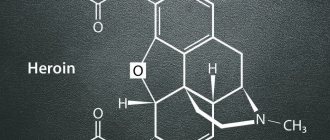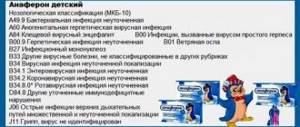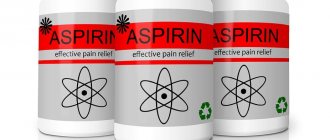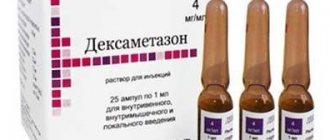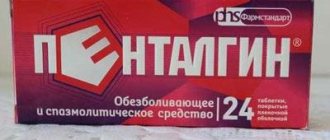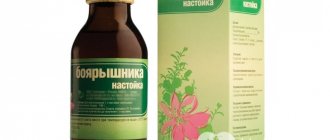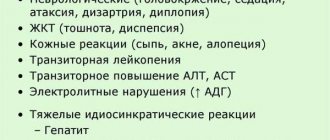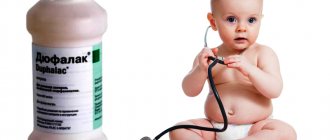Category: Drug poisoning
An overdose of Remantadine is quite rare, but the consequences of this phenomenon can be extremely severe.
Remantadine is one of the most well-known drugs, judging by its time on the pharmaceutical market and relative budget cost.
The drug stimulates the immune system and fights the toxic effects of viruses on the human body. In addition, it is actively used to prevent influenza.
The active ingredient is Remantadine, which stops the harmful effects of the virus in the initial stages of the disease. The drug is characterized by rapid action and rather slow absorption in the stomach and intestines. One of the important properties is the possibility of prescribing the drug to children from the age of seven.
Remantadine is contraindicated in:
- pregnancy;
- breastfeeding;
- chronic arterial diseases;
- hyperthyroidism;
- epilepsy;
- liver and kidney diseases.
So how to use Remantadine?
General characteristics of rimantadine
The active ingredient of the drug is rimantadine, which has a detrimental effect on viruses and helps improve immunity. The drug can be taken for both preventive and therapeutic purposes . It allows you to alleviate the course of the disease and avoid the consequences of the flu, as well as prevent infection with the influenza A strain. The medicine is eliminated from the body through the urinary system, and up to 15% comes out unchanged. The half-life reaches 36 hours.
Pharmaceutical companies produce remantadine in the form of tablets, syrup for children and powder for resorption.
The drug is not prescribed to pregnant and lactating women, as well as children under 7 years of age . Remantadine does not affect psychomotor activity at all, so during treatment you can drive a car and engage in activities that require increased attention.
No interaction with other drugs was detected.
Although the annotation states that the drug should not be used by children under 7 years of age, some pediatricians successfully use it in their practice. The dosage in this case is calculated individually based on the child’s weight.
Side effects
Remantadine is usually well tolerated by patients of all age groups. In rare cases, there may be side effects associated with digestive disorders or disruptions in the nervous system. In addition, there may be hearing loss and hoarseness .
If any side effects occur, you must notify your doctor, who will adjust the treatment if necessary.
Release form and composition
To understand what Remantadine tablets are for, you need to study all the properties of this medication. Experts have proven that the active substance of the drug is a white crystalline powder that dissolves well in alcohol. The final composition of auxiliary microelements depends on the form of release. The main active ingredient of the drug is rimantadine. The composition also includes auxiliary components:
- magnesium stearate;
- corn starch;
- anhydrous colloidal silicon dioxide;
- lactose monohydrate.
The drug is available in two forms. Capsules of 100 mg are sold in blister packs. Tablets of 50 mg are packaged in blisters of 10 pieces.
How much rimantadine can lead to an overdose?
For preventive purposes, adults take 1 tablet of rimantadine per day, the course lasts a month. Children over 7 years old: 1 tablet for 2 weeks. If one tablet is accidentally missed, then you should not take a double dose; continue taking it as usual .
When treating influenza, the dosage regimen is slightly different for both adults and children:
- adults take 6 tablets on the first day of illness, at regular intervals. 4 tablets per day on the second and third days of illness, 2 tablets on days 4-5;
- children from 7 to 10 years old take 1 tablet 2 times a day;
- children from 10 to 14 years old take 1 tablet 3 times a day.
The general course of treatment for children and adults should not exceed five days.
An overdose of rimantadine is possible if the therapeutic dosage is exceeded, which is indicated in the annotation for the drug. For adults, the maximum permissible daily dose is 300 mg of the drug, for a child – 100-150 mg of the drug.
Description of the drug
Remantadine tablets were patented by pharmacists in 1965 in the USA. Later, experts conducted special tests among volunteers, due to which they were able to prove the high effectiveness of the drug. Today the drug belongs to the category of synthetic substances. This is one of the few derivatives of adamantane (a chemical compound that occurs naturally in petroleum). The tablets are effective for routine prevention and treatment of type A influenza, as well as to prevent the development of the active stage of tick-borne encephalitis.
Signs of overdose
Symptoms of an overdose include the following changes in health status:
- persistent indigestion appears - nausea, vomiting and heartburn;
- bloating and severe diarrhea develop;
- an allergic rash appears on the body;
- body temperature rises;
- there may be tinnitus;
- coordination of movements is impaired, the patient staggers when walking;
- abnormal drowsiness occurs;
- attention is impaired, general weakness appears;
- mental disorders appear - an inexplicable feeling of fear, anxiety. The victim is constantly in a depressed mood;
- heart function is disrupted.
If the overdose is very strong, there may be hallucinations and atypical psychomotor agitation. When the victim has chronic heart disease, an overdose may cause cardiac arrest .
Adverse reactions
After reading the instructions for the Remantadine tablets, you can understand that almost all patients tolerate the effects of the medication on the body well. But exceeding the permissible dosage is fraught with the development of side effects:
- insomnia;
- flatulence;
- dizziness;
- impaired concentration and psychomotor activity;
- acute abdominal pain;
- dryness of the oral mucosa;
- severe nausea, vomiting;
- mild headaches;
- a significant increase in the concentration of bilirubin in the blood plasma.
Allergic reactions are accompanied by profuse skin rashes, itching, and burning. If at least one side effect occurs, you should consult your doctor. During treatment, it is better to refrain from driving a car, as well as performing work that requires increased concentration of attention from a person. Instructions for using Remantadine tablets by adults and methods for calculating the optimal dosage help to avoid the most common mistakes.
Help before the doctor arrives
If a person has an overdose of rimantadine, then it is necessary to quickly call an ambulance, and then begin providing emergency care. What you can do before the doctor arrives:
- If less than two hours have passed since the poisoning, then gastric lavage will be effective to remove any remaining medication that has not had time to be absorbed into the bloodstream. The patient is given up to 1 liter of a weak solution of potassium permanganate or table salt to drink. After this, they press on the tongue and induce vomiting. This procedure needs to be done up to 5 times so that the stomach is thoroughly cleansed.
- Grind activated carbon and dissolve it in a glass of water, give this solution to the victim. Tablets are taken at the rate of 1 piece. per 10 kg body weight.
- Provide the patient with plenty of fluids. Tea with lemon and honey, cranberry juice and various jelly are good options.
You should not try to perform gastric lavage at home for children under 3 years of age. This contributes to rapid dehydration of the body, which can be fatal. If a child is poisoned, you should quickly call a doctor or take the child to the nearest medical facility.
Notes[ | ]
- ↑ 1 2 3 4 5 6 7 8
Search in the drug database, search options: INN -
Rimantadine
, flags
“Search in the register of registered drugs”
,
“Search TKFS”
,
“Show lekforms” (undefined)
(inaccessible link).
Circulation of medicines
. Federal State Institution “Scientific Center for Expertise of Medical Products” of Roszdravnadzor of the Russian Federation. — A standard clinical and pharmacological article is a by-law and is not protected by copyright in accordance with part four of the Civil Code of the Russian Federation No. 230-FZ of December 18, 2006. Retrieved March 27, 2008. Archived September 3, 2011. - ↑ 1 2 3
Rimantadine (
unspecified)
(inaccessible link).
Encyclopedia of Medicines
. Register of Medicines of Russia (1998). Retrieved March 22, 2008. Archived January 9, 2008. - Antiviral Agents for the Treatment and Chemoprophylaxis of Influenza : Recommendations of the Advisory Committee on Immunization Practices : Recommendations and Reports : [English] : pdf / Prepared by Anthony E. Fiore (MD), Alicia Fry (MD), David Shay (MD ), Larisa Gubareva (PhD), Joseph S. Bresee (MD), Timothy M. Uyeki (MD), Influenza Division, National Center for Immunization and Respiratory Diseases. — Morbidity and Mortality Weekly Report. — Centers for Disease Control and Prevention, 2011. — Vol. 60, No. 1 (21 January). - P. 2, 7. - ISSN 1546-0738.
- Resolution of the Meeting of the Presidium of the Formal Committee of the Russian Academy of Medical Sciences on March 16, 2007: doc. — RAMS. — P. 2.
Immediately remove from the list of medicines for which drug provision is provided in the DLO program, outdated drugs with unproven effectiveness - cerebrolysin, trimetazidine, chondroitin sulfate, vinpocetine, piracetam, phenotropil, arbidol, rimantadine, validol, inosine ,
valocordin, etc., including , available without a prescription. - US Patent No. 3352912 for a new amantadine derivative (W. W. Prichard)
- EI DuPont de Nemours and Company, Wilmington, Delaware, USA
- United States Patent No. 4551552: Process for preparing rimantadine: “ Rimantadine and related compounds useful as antivirals were first described by Prichard in US Pat.
Nos. 3,352,912 and 3,592,934. Both patents describe the preparation of rimantadine from the corresponding ketone oxime by reduction with lithium aluminum hydride ." - Rimantadine
- DM Zlydnikov, OI Kubar, TP Kovaleva, LE Kamforin. Study of Rimantadine in the USSR: A Review of the Literature. Clinical Infectious Diseases 3:408-421, p.408: “ The promising results obtained with amantadine and the encouragement of Academician AA Smorodintsev, led, in 1969, to the initiation of investigations of the new American derivative, rimantadine (Du Pont & Co ., Wilmington, Del.)
." - Tsunada A, Maasab HF, Cochran KW, Eveland WC. Antiviral activity of alpha-methyl-l-adamantane methylamine hydrochloride. Antimicrobial Agents and Chemotherapy, 553, 1965.
- Dawkins AT Jr, Gallager LR, Togo Y, Hornick RB, Harris BA. Studies on Influenza Influenza in Man. JAMA 203:1089, 1968.
- Rabinovich S, Baldini JT, Bannister R. Treatment of influenza. The therapeutic efficacy of rimantadine HCL in a naturally occurring influenza A2 outbreak. American Journal of Medical Sciences, 257(5):328–335, 1969.
- DM Zlydnikov, OI Kubar, TP Kovaleva, LE Kamforin. Study of Rimantadine in the USSR: A Review of the Literature. Clinical Infectious Diseases 3, 408-421, 1981
- Main achievements of the lab in the development of new antivirals (inaccessible link)
- Antiviral Agents for the Treatment and Chemoprophylaxis of Influenza
- Letter of the Federal Service for Surveillance on Consumer Rights Protection and Human Welfare (USA) No. 01/5583-9-23 dated 04/26/2009 “On sending materials on safety measures for working with the swine influenza pathogen and patients”
How is treatment done in a hospital?
If the victim's condition is serious, he is shown an antidote, which is physostigmine. This drug is administered in a dose of 1-2 mg and, according to indications, the administration of the drug is repeated every hour.
There is no point in performing hemodialysis, since it helps to remove only 5% of the toxin. You can significantly speed up the removal of rimantadine from the body by acidifying the urine; for this, medications, ascorbic acid, or an acidic drink are used. If there is no urination for more than 4 hours, a catheter is used to empty the bladder .
The patient is placed in the intensive care unit and closely monitored. They periodically do a cardiogram, measure blood pressure and body temperature. These actions will help to timely identify possible complications after an overdose and prescribe adequate treatment.
Pharmacological principle of action
If the patient wants to understand what the Remantadine tablets are for, then you need to pay attention to the properties of this drug. The drug compares favorably with all analogues in its powerful antiviral effect, as it belongs to ion channel inhibitors that are built into the shell of a dangerous virus. The active substance inhibits the disease at an early stage and also blocks the development of painful symptoms.
The tablets are taken exclusively orally, the maximum effect is achieved 30 minutes after use. It is worth noting that the active substance is characterized by slow metabolization, due to which the drug remains in the patient’s blood for a long time. Taking Remantadine cannot replace complete prevention of dangerous encephalitis. Treatment must be comprehensive. The antiviral medication is characterized by gradual absorption and is well absorbed by the intestinal mucosa. Remains of the drug are excreted from the body along with urine.
Possible consequences of overdose
If the overdose of rimantadine was not severe and medical assistance was provided immediately, then there will be no health consequences. Complications are possible in patients with a history of hypertension; their blood pressure rises due to an overdose - this often leads to a heart attack or stroke .
Severe intoxication, even with timely assistance, can lead to death. If the victim was nevertheless saved, he still has diseases of the nervous system for a long time, sometimes turning into mental illness.
How to take the antiviral medicine "Remantadine" for prevention against a tick bite?
The antiviral drug "Remantadine" has positively proven itself as a prophylactic against tick-borne encephalitis, borreliosis and Lyme disease, if timely and correct use of the tablets was started. It is very important to do a laboratory analysis of the bitten tick before carrying out therapy. If the insect is a carrier of a viral pathogenic microflora, then prevention may include the administration of specific immunoglobulins and the concomitant use of this drug.
Before drinking Remantadine if you are bitten by a tick, you should find out about possible contraindications and carefully calculate the dosage taking into account existing concomitant diseases. This will eliminate side effects and negative consequences that may persist for quite a long time.
Prevention with Remantadine in cases of bites by infected ticks gives a positive result only if you start taking the tablets in the first three days after the incident. A late appointment is absolutely useless. How to take the product can be seen in the table above. If all rules are followed, there is a complete absence of clinical signs of tick-borne encephalitis and the development of long-term negative consequences of this type of infection. In some cases, the disease occurs in the form of a respiratory syndrome with aches in large joints and muscles, headache, runny nose and an increase in body temperature to subfebrile parameters.
How to prevent overdose
When taking Remantadine for therapeutic or prophylactic purposes, you should be careful and attentive:
- Do not exceed the dose of the drug that was recommended by the doctor.
- Do not leave the medicine package within reach of a child.
- It is strictly forbidden to take expired medications.
- Under no circumstances should you self-medicate or prescribe medications yourself.
- You should not drink alcohol during treatment.
Some doctors prefer to prescribe more modern immunostimulating drugs instead of rimantadine, believing that influenza strains are already resistant to this medicine. But the medicine continues to be popular among the population and helps increase immunity to certain viruses.
Available analogues
In modern pharmacies, each patient can purchase different types of medicines that cope well with viral infections and are used to prevent ARVI. The following medications are in greatest demand:
- "Arbidol".
- "Algirem".
- "Amiksin".
- "Kagocel".
- "Rimantadine."
- "Ingavirin".
- "Orvirem."
- "Remantadine-STI".
The choice of drug depends on the patient’s tolerability of the main components and the recommendations of the attending physician. When purchasing, it is better not to be guided by price; the main thing is the therapeutic effect.
